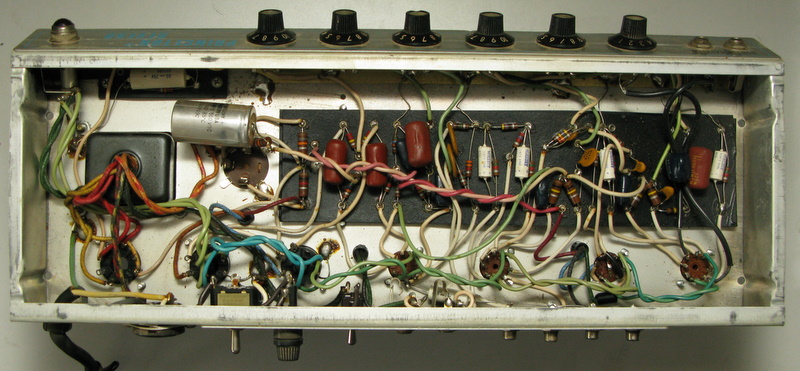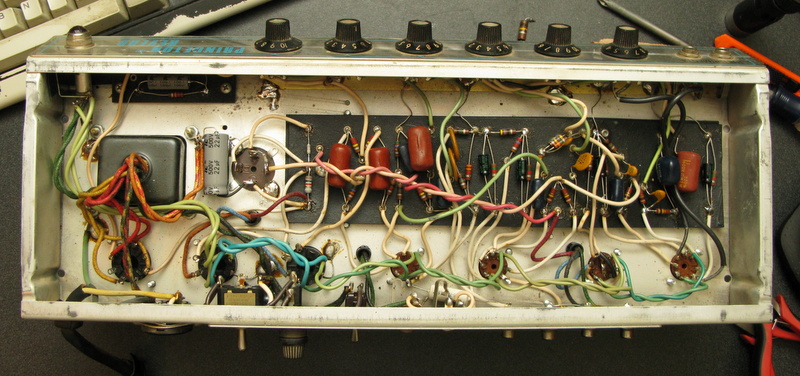I picked up a mid '70s Princeton Reverb on my local CL a short while back & have been enjoying getting it up & running. Came to me with some nasty hum, a swiss cheese CTS from a mid '60s Super, a dead reverb tank & some REALLY yucky "splattery" distortion on anything above medium pick attack, even at medium volumes. . .
I had the Reverb tank re-built, re-capped the amp (new 20/20/20/20 can + 22/500 on the first stage, Atoms for all the 25/25s, replaced bias cap) + all the "usual suspect" resistors. I've also been playing with other 10" speaker options. Have FIVE to play with at the moment, my current favorite being an old C10N with a recent re-cone by Weber. Put in a set of JJs 6V6s - the amp had all old glass when it came to me, but the GE 6V6s were obviously tired, the JJs brought quite a bit of life to the party. I have swapped in known good tubes in all other positions & feel pretty comfortable with the old GEs in V1-4 & the 5U4.
SO, now the reverb works, the speaker sounds fantastic, the amp idles quiet and all is well in Princetonland EXCEPT, the attack distortion is still present and TOTALLY bumming me out. . .
I did some "interneting" and saw mention of the reverb transforming crapping out, especially in the middle/later SF amps, so I pulled V2 & VOILA - the amp sounds lovely. Can dime it & there the attack distortion is completely gone. . .put V2 back & its nasty again. SO, thinking I'd found the problem, I put in a new reverb transformer (ClassicTone, was available locally), no change. Still sounds great with V2 pulled, awful with V2 in place. I've swapped in two other AT7s there and neither makes a bit of difference.
SO - given all of this - what do I need to be looking at next? Any help is greatly appreciated, of course!!!
Oh, some pix might help, 'eh!? (can certainly provide larger versions of either, more detailed shots, etc.)
Before:

After:

I had the Reverb tank re-built, re-capped the amp (new 20/20/20/20 can + 22/500 on the first stage, Atoms for all the 25/25s, replaced bias cap) + all the "usual suspect" resistors. I've also been playing with other 10" speaker options. Have FIVE to play with at the moment, my current favorite being an old C10N with a recent re-cone by Weber. Put in a set of JJs 6V6s - the amp had all old glass when it came to me, but the GE 6V6s were obviously tired, the JJs brought quite a bit of life to the party. I have swapped in known good tubes in all other positions & feel pretty comfortable with the old GEs in V1-4 & the 5U4.
SO, now the reverb works, the speaker sounds fantastic, the amp idles quiet and all is well in Princetonland EXCEPT, the attack distortion is still present and TOTALLY bumming me out. . .
I did some "interneting" and saw mention of the reverb transforming crapping out, especially in the middle/later SF amps, so I pulled V2 & VOILA - the amp sounds lovely. Can dime it & there the attack distortion is completely gone. . .put V2 back & its nasty again. SO, thinking I'd found the problem, I put in a new reverb transformer (ClassicTone, was available locally), no change. Still sounds great with V2 pulled, awful with V2 in place. I've swapped in two other AT7s there and neither makes a bit of difference.
SO - given all of this - what do I need to be looking at next? Any help is greatly appreciated, of course!!!

Oh, some pix might help, 'eh!? (can certainly provide larger versions of either, more detailed shots, etc.)
Before:
After:


Comment